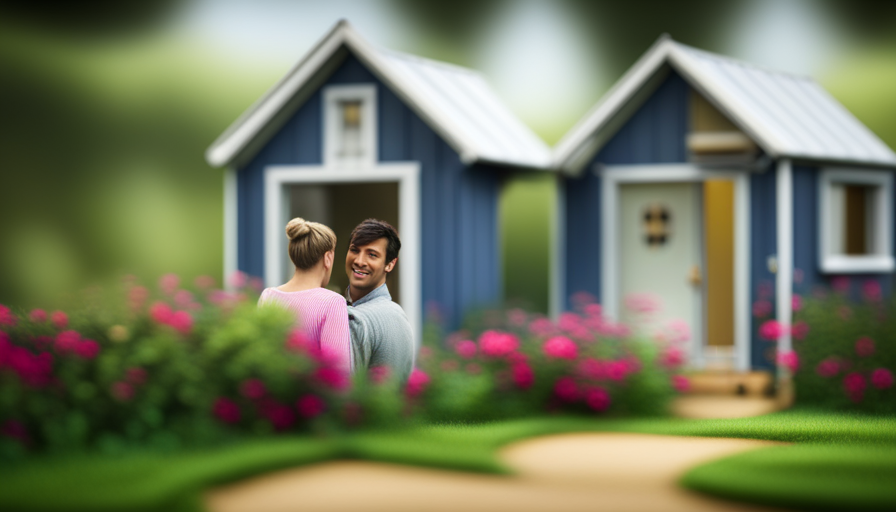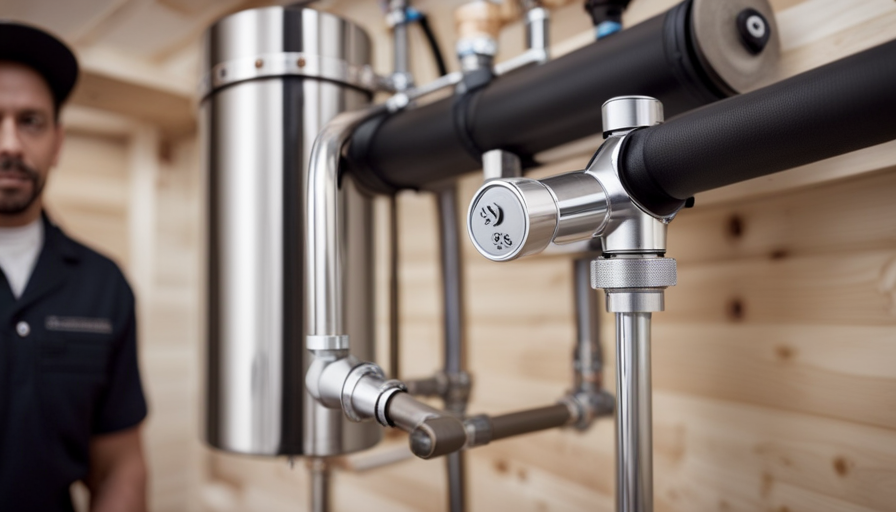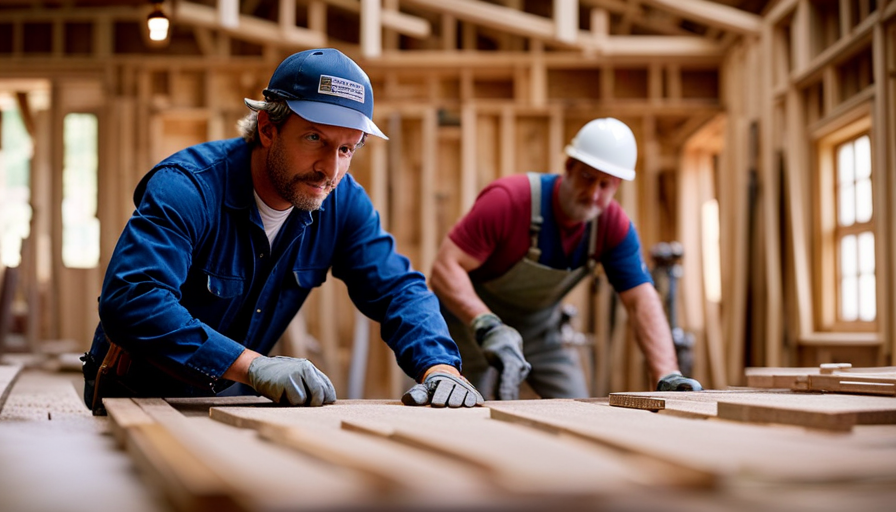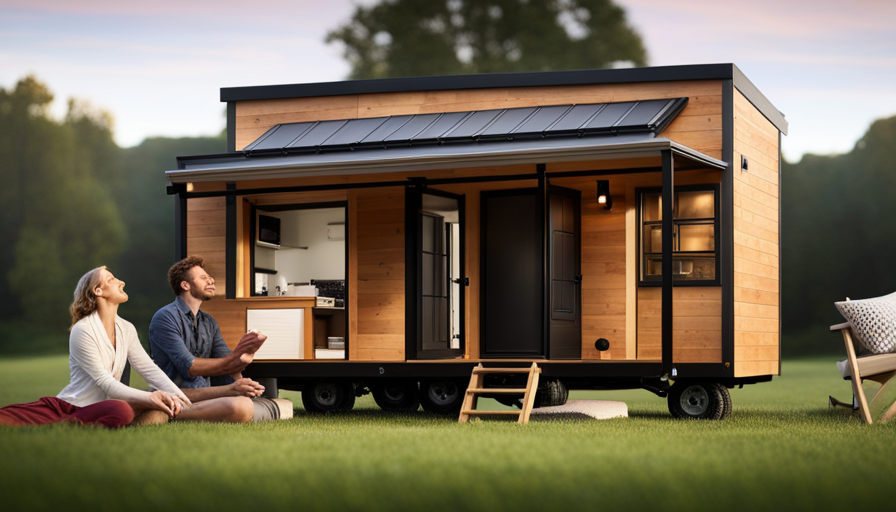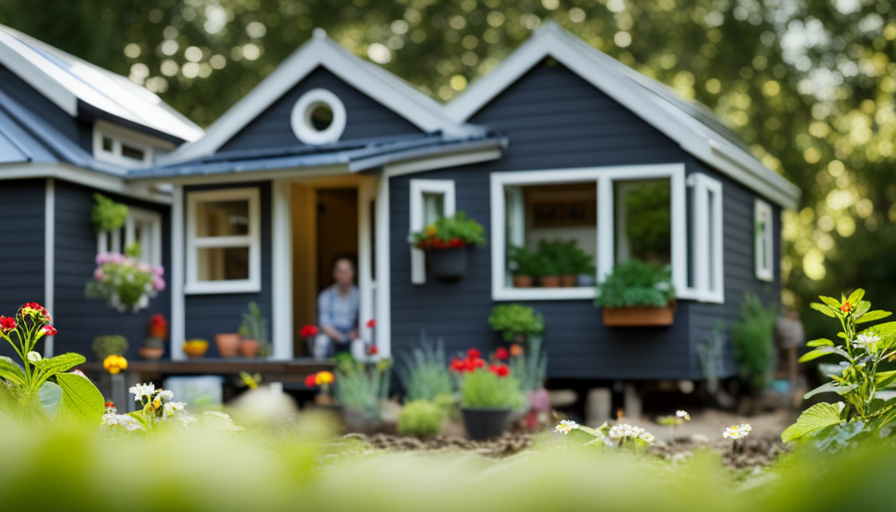Living in a compact dwelling can satisfy the dreams of those seeking a simpler and environmentally friendly lifestyle. However, navigating and adhering to the legal guidelines can seem daunting. Having resided in a tiny home within legal limits, I am familiar with the challenges and intricate details involved in this way of life.
In this article, I will guide you through the steps to ensure that you can legally live in a tiny house without any hassles. By juxtaposing the desire for a tiny house with the need for legal compliance, we will explore various aspects such as local zoning laws, permits, building codes, suitable land options, and alternative living arrangements.
Additionally, we will delve into the realm of off-grid living and sustainable practices, as well as insurance considerations for your tiny house. It is crucial to stay informed about the ever-changing legal developments and regulations surrounding tiny houses, and I will provide you with the necessary resources to do so.
With this knowledge, you can confidently embark on your journey towards legal and fulfilling tiny house living.
Key Takeaways
- Research and understand local zoning laws and regulations before making decisions about living in a tiny house.
- Familiarize yourself with building codes to ensure your tiny house meets safety standards.
- Consider joining a tiny house community or village for support, knowledge exchange, and shared resources.
- Consult with a legal professional to ensure compliance with laws and regulations and understand permits, zoning laws, and tax implications.
Understand Local Zoning Laws and Regulations
It’s crucial to understand local zoning laws and regulations if you want to live in a tiny house legally. Understanding local permits and exploring tiny house friendly cities are key factors in ensuring you can live in a tiny house without any legal issues.
When it comes to zoning laws, each city and county has its own set of rules and regulations. Some areas have specific guidelines for tiny houses, while others may not mention them at all. It’s important to research and understand these laws before making any decisions.
One way to determine if a city is tiny house friendly is to explore the local regulations and see if they allow for smaller, more sustainable homes. Some cities have embraced the tiny house movement and have created zoning laws that accommodate these dwellings. These cities often have designated areas or communities where tiny houses are allowed.
Additionally, it’s important to determine if a permit is required for your tiny house. Some areas may require a permit for any type of dwelling, regardless of size. Others may have specific regulations for tiny houses, such as minimum square footage or foundation requirements. Understanding these permit requirements will help ensure that your tiny house is legally compliant.
By understanding local zoning laws, exploring tiny house friendly cities, and determining if a permit is required, you can navigate the legalities of living in a tiny house. Now, let’s move on to the next section and discuss how to determine if a permit is required for your tiny house.
Determine if a Permit is Required for Your Tiny House
To ensure compliance with local regulations, finding out whether a permit is necessary for your compact dwelling can save you from potential legal complications. Permit requirements for tiny houses may vary depending on the location and local zoning laws. Understanding these requirements is essential before embarking on your tiny house journey. Here are five important considerations when determining if a permit is required for your tiny house:
-
Research local building codes: Each jurisdiction has its own set of rules and regulations regarding construction and dwelling sizes. Familiarize yourself with these codes to determine if a permit is necessary.
-
Consult with local authorities: Reach out to your local building department or planning office to inquire about permit requirements specifically for tiny houses.
-
Identify specific zoning regulations: Some areas have specific zoning regulations for tiny houses, which may impact the need for a permit. Determine if your property falls within a designated zone for tiny houses.
-
Determine the size and features of your tiny house: Some jurisdictions have size restrictions or requirements for tiny houses. Understanding these limitations will help you determine if a permit is necessary.
-
Consider the intended use of your tiny house: Different permit requirements may apply if you plan to use your tiny house as a primary residence, vacation home, or rental property.
By familiarizing yourself with the permit requirements and zoning regulations, you can ensure a smooth and legal process when living in a tiny house. Moving forward, it’s important to also familiarize yourself with building codes to ensure your tiny house meets all safety standards.
Familiarize Yourself with Building Codes
Make sure you brush up on building codes, or you risk facing the wrath of the construction gods and their mighty hammers of justice. Familiarizing yourself with building codes is crucial for ensuring that your tiny house is legal and safe.
Building codes are regulations that dictate the standards for construction and design. They include requirements for building materials and construction techniques.
When it comes to building materials, building codes often specify the type and quality of materials that can be used. This ensures that your tiny house is structurally sound and built to withstand the elements. Building codes may also require certain fire-resistant materials to be used, especially if your tiny house is located in an area prone to wildfires.
Construction techniques are another important aspect covered by building codes. These codes outline the proper methods for constructing different parts of your tiny house, such as the foundation, framing, electrical wiring, plumbing, and insulation. Adhering to these guidelines not only ensures the safety of your tiny house but also helps prevent any potential issues that may arise during inspections.
Understanding building codes is essential for living in a tiny house legally. By following these regulations, you can avoid penalties and ensure that your tiny house meets all necessary safety standards.
So, let’s move on to the next step and find suitable land for your tiny house.
Find Suitable Land for Your Tiny House
Once you’ve familiarized yourself with building codes, it’s time to scout out the perfect plot of land for your cozy abode. Finding affordable land can be a challenge, but with some research and persistence, it is possible to find suitable options. Dealing with local authorities is an important aspect of this process as they have the power to approve or deny your plans.
To assist you in your search, I have created a table below that outlines key considerations when looking for land for your tiny house:
| Consideration | Description |
|---|---|
| Zoning regulations | Check local zoning regulations to ensure that tiny houses are allowed in the area. Some areas may have specific requirements for minimum square footage or permanent foundations. |
| Utility access | Determine if the land has access to utilities such as water, electricity, and sewage. If not, you may need to explore alternative options such as off-grid systems. |
| Cost | Evaluate the cost of the land and consider your budget. Look for affordable options that align with your financial goals. |
| Location | Consider the proximity to amenities such as grocery stores, healthcare facilities, and employment opportunities. Also, think about the climate and natural surroundings. |
| Community | Research the community and its values. Look for areas that are welcoming to tiny house living and have supportive local authorities. |
Once you have found a suitable plot of land, consider joining a tiny house community or village to connect with like-minded individuals and gain additional support in navigating the legalities of living in a tiny house.
[Subsequent section transition: Now that you have found the perfect plot of land, consider joining a tiny house community or village.]Consider Joining a Tiny House Community or Village
Joining a tiny house community or village can provide a supportive network of like-minded individuals. Over 50% of tiny house owners report increased happiness and sense of community after joining. It’s a great way to connect with others who share your passion for tiny living and can offer valuable advice and support. Here are four reasons why joining a community or finding a village is beneficial:
-
Shared Resources: Being part of a community means you can share resources like tools, equipment, and even land. This can significantly reduce costs and make living in a tiny house more affordable.
-
Knowledge Exchange: In a tiny house community, you’ll have the opportunity to learn from others who have already gone through the process of living legally in a tiny house. They can provide guidance on zoning laws, building codes, and other legal considerations.
-
Social Events and Activities: Many tiny house communities organize social events and activities for their members. This creates a sense of belonging and provides opportunities for friendship and networking.
-
Supportive Environment: Living in a tiny house can sometimes be challenging, but being part of a community can provide emotional support and encouragement. You’ll have people who understand your lifestyle and can offer advice and solutions to any problems you may encounter.
By joining a community or finding a village, you can benefit from the collective knowledge and support of others who have already navigated the legal aspects of living in a tiny house. Next, it’s important to consult with a legal professional to ensure you’re adhering to all applicable laws and regulations.
Consult with a Legal Professional
To ensure you’re in compliance with all relevant laws and regulations, it’s crucial to seek guidance from a legal professional when pursuing your tiny house dreams. There are a number of legal implications when it comes to living in a tiny house, and consulting with a legal expert can help you navigate through the complexities of these regulations.
One important aspect to consider is the permitting process. Different areas have different requirements for tiny houses, and it’s important to understand what permits you may need before you start building or moving into your tiny house. A legal professional can help you understand the local zoning laws, building codes, and any restrictions that may apply to your specific situation.
Additionally, a legal professional can provide you with advice on how to structure your ownership of the tiny house, whether it’s through purchasing, leasing, or other arrangements. They can also help you understand any tax implications that may arise from living in a tiny house.
By consulting with a legal professional, you can gain a better understanding of the legal implications and requirements of living in a tiny house, ensuring that you’re in compliance with all relevant laws. This will give you peace of mind as you pursue your tiny house dreams.
To explore alternative living options, such as RV parks or campgrounds, it’s important to understand the legal aspects of these arrangements as well.
Explore Alternative Living Options, such as RV Parks or Campgrounds
There are various options available for individuals seeking an alternative and convenient living arrangement, such as exploring the possibilities of RV parks or campgrounds. These options provide an opportunity to legally live in a tiny house while enjoying the amenities and community of these established locations.
RV parks and campgrounds often have designated areas for tiny houses, allowing residents to have access to water, electricity, and sewage facilities.
One advantage of living in RV parks or campgrounds is the sense of community that comes with it. These places often host social events and activities, providing opportunities to meet like-minded individuals who share similar interests in alternative living. Additionally, the close proximity to nature offers a chance to enjoy outdoor activities, such as hiking or fishing, right at your doorstep.
It is important to note that each RV park or campground may have specific regulations regarding the size, design, and duration of stay for tiny houses. Some may require a certain length of stay or impose restrictions on permanent residency. Therefore, it’s crucial to thoroughly research and contact the management of these locations to ensure compliance with their rules and regulations.
In the next section, we’ll learn about off-grid living and sustainable practices, which can further enhance the experience of living in a tiny house.
Learn About Off-Grid Living and Sustainable Practices
Immerse yourself in the world of off-grid living and sustainable practices, like a bee buzzing around a field of wildflowers, to enhance your experience in a tiny house. Living off-grid means relying on renewable sources of energy, such as solar panels or wind turbines, to power your home. Not only does this reduce your carbon footprint, but it also frees you from the constraints of traditional utility bills.
Additionally, using sustainable materials in the construction of your tiny house not only minimizes environmental impact but also ensures a healthier living space for you and the planet. Consider using reclaimed wood or recycled materials for your flooring, walls, and furniture.
To fully embrace off-grid living and sustainable practices in your tiny house, here are four key steps you can take:
- Invest in off-grid energy solutions, such as solar panels or wind turbines, to generate your own electricity.
- Maximize energy efficiency by using low-energy appliances, LED lighting, and well-insulated windows and doors.
- Implement water conservation strategies, such as rainwater harvesting or installing low-flow fixtures, to minimize water usage.
- Embrace sustainable waste management practices, such as composting or recycling, to reduce your environmental impact.
By incorporating these practices into your tiny house lifestyle, you can create a more self-sufficient and environmentally friendly living space.
Now, let’s dive into the next section and educate ourselves on insurance options for tiny houses.
Educate Yourself on Insurance Options for Tiny Houses
Get ready to discover the various insurance options available for your cozy abode on wheels, so you can protect your tiny house and embark on worry-free adventures. Insurance coverage is essential for any homeowner, and it’s no different for tiny house dwellers.
While traditional homeowner’s insurance may not cover tiny houses, there are specialized insurance policies designed specifically for these unique dwellings.
When considering insurance coverage for your tiny house, there are a few factors to keep in mind. First, you need to determine if you’ll be using your tiny house as a primary residence or as a secondary dwelling. This will affect the type of insurance coverage you need. Additionally, you should consider the value of your tiny house and any personal belongings you have inside. It’s important to choose a policy that provides adequate coverage for both.
Financing options can also play a role in insurance coverage for your tiny house. If you’ve taken out a loan to finance your tiny house, your lender may require you to have insurance as a condition of the loan. Be sure to check with your lender to understand their specific insurance requirements.
Understanding insurance options is crucial for protecting your tiny house. Once you’ve secured the appropriate coverage, you can move on to the next step: staying up-to-date on legal developments and changes in tiny house regulations.
Stay Up-to-Date on Legal Developments and Changes in Tiny House Regulations
Staying informed about legal developments and changes in regulations is crucial to ensure that your tiny house journey remains hassle-free and compliant with the law. Understanding the importance of community building is key when it comes to staying up-to-date on legal developments for tiny houses. Joining local and online communities dedicated to tiny house living can provide valuable information and insights into changes in regulations.
These communities often share updates on zoning laws, building codes, and permit requirements, helping you navigate the legal landscape.
Overcoming challenges in obtaining permits is another aspect of staying informed about legal developments. While some areas have embraced the tiny house movement and have created specific regulations for them, others may still have restrictive codes or limited options for legal placement. By staying updated on legal developments, you can identify potential challenges in advance and seek creative solutions. This might involve working with local officials, advocating for changes in regulations, or exploring alternative housing options such as backyard cottages or accessory dwelling units.
Staying informed about legal developments and changes in regulations is essential for living in a tiny house legally. By understanding the importance of community building and overcoming challenges in obtaining permits, you can navigate the legal landscape with confidence and ensure a hassle-free tiny house journey.
Frequently Asked Questions
Can I legally live in a tiny house on wheels in a residential neighborhood?
Living in a tiny house on wheels in a residential neighborhood is subject to tiny house zoning regulations and legal requirements. It’s important to thoroughly research and understand these rules to ensure compliance and avoid any potential legal issues.
Are there any specific building codes that I need to follow when constructing a tiny house?
When constructing a tiny house, there are specific building codes and zoning regulations that need to be followed. These codes ensure the safety and compliance of the structure, making it legally permissible to live in.
Can I park my tiny house on someone else’s property without a permit?
I cannot park my tiny house on someone else’s property without a permit. Parking regulations and zoning restrictions vary depending on the location. It is important to check with local authorities to ensure compliance with the law.
Are there any tax benefits or incentives for living in a tiny house?
Yes, there are tax benefits and financial incentives for living in a tiny house. These include potential deductions for mortgage interest, property taxes, and energy-efficient upgrades. Additionally, some states offer grants or tax credits for tiny house owners.
What are the insurance options for a tiny house, and how do they differ from traditional homeowners insurance?
Tiny house insurance options differ from traditional home insurance in that they cater specifically to the unique needs of tiny house owners, providing coverage for theft, damage, and liability. Comparison between the two helps determine the best option for your tiny house.
Conclusion
In conclusion, navigating the legalities of living in a tiny house requires diligence and a deep understanding of the local regulations. It’s crucial to stay informed about zoning laws, building codes, and permit requirements to ensure a smooth and legal living experience.
Joining a tiny house community or exploring alternative living options can also provide valuable support and resources. Embracing off-grid living and sustainable practices can enhance the tiny house lifestyle.
Remember, staying up-to-date on legal developments is essential to stay in compliance with evolving regulations. As they say, "knowledge is power," and in the world of tiny houses, it’s the key to a legally sound and fulfilling living experience.
Hi, I’m Emma. I’m the Editor in Chief of Tiny House 43, a blog all about tiny houses. While tree houses are often associated with childhood, they can be the perfect adult retreat. They offer a cozy space to relax and unwind, surrounded by nature. And since they’re typically built on stilts or raised platforms, they offer stunning views that traditional homes simply can’t match. If you’re looking for a unique and romantic getaway, a tree house tiny house might just be the perfect option.
